What type of content do you primarily create?




If you’re here, it’s probably not because VEED.io is bad, but maybe it’s just not enough for you.
The VEED website had about 16.7 million visits in September 2025, so clearly, the platform is popular.
But perhaps you’re ready for something more collaborative, more future-proof—something like Descript.
We’ll let you make the decision for yourself, though.
We’ll compare the best features of the top VEED.io alternatives for 2026, so you get a clear, fair baseline of what each platform does well, and where it falls short.
Toward the end, you’ll find a decision matrix to help you pick the right AI-powered video editing platform for your workflow.
Why look for a VEED.io alternative?
VEED has a 4.6-star rating on G2 from 1,500+ reviews, so it’s doing a lot right. We know that a perfect 5-star rating for any fast-growing software is fiction.
However, what does matter is the pattern—the trends, the complaints that keep resurfacing even as the platform ships shiny new features.
When you zoom into VEED’s recent reviews, a few notable cracks show up:
- Slow performance (231 mentions): “...runs a little slow when projects get bigger, which makes it harder to keep working smoothly.”
- Limited features (226 mentions): “I find it challenging that VEED does not have the capability to adjust picture and colors, which is something I currently have to use another editing tool for.”
- AI limitations (167 mentions): “Editing with AI Script is the worst. I'm never able to edit within the generated captions.”
- Limited customization (156 mentions): “Some advanced editing features are limited, and rendering can slow down with larger files. More integration options and deeper audio controls would be helpful.”
- Expensive (186 mentions): “The overall pricing model is too expensive for the features offered, especially when compared to alternatives like ChatGPT, which provide comparable transcription accuracy for free.”
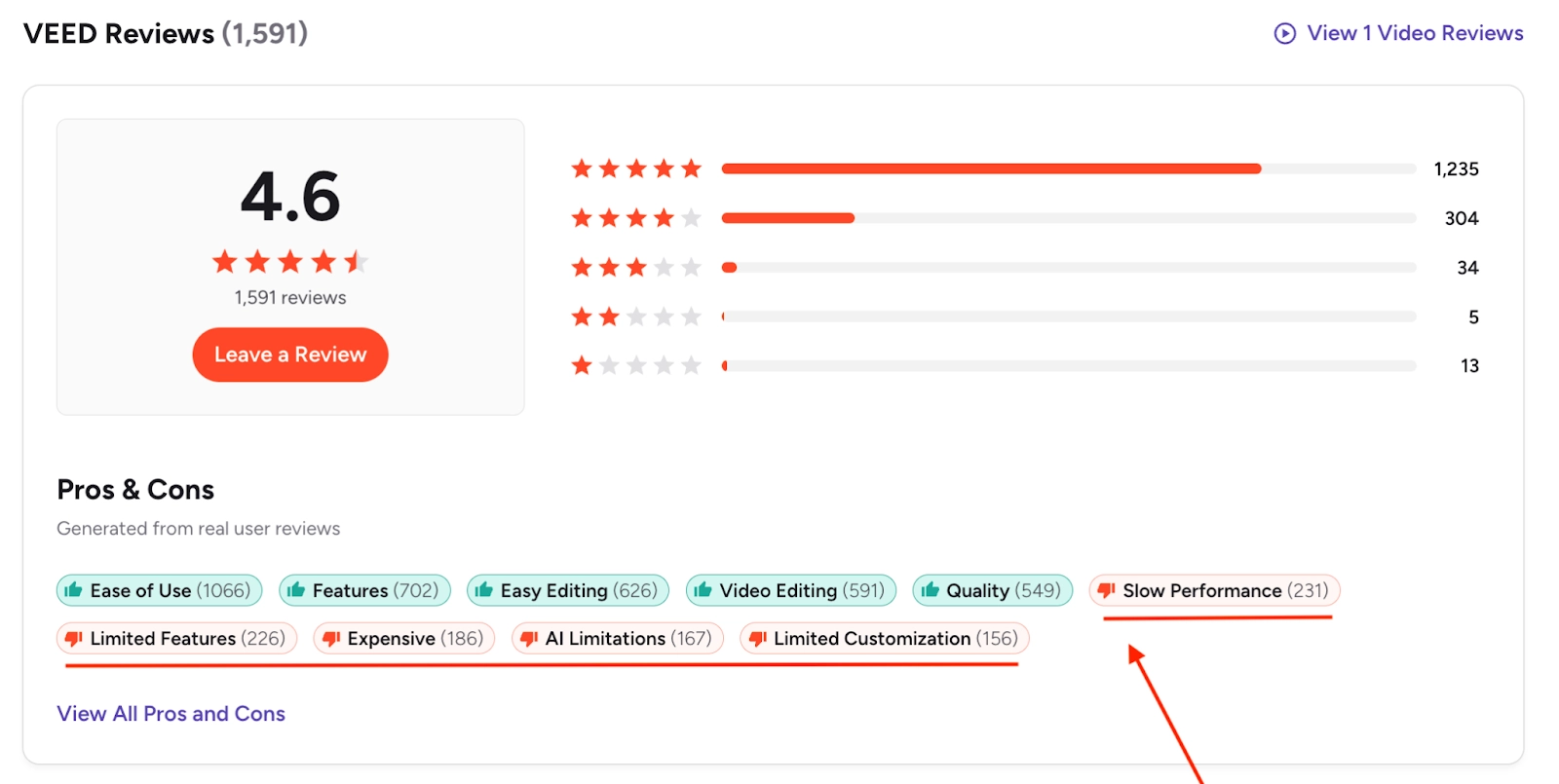
This lines up with what G2’s AI video insights report says:
“Customers love what the product can do, but don’t like what it can’t help them control.”
VEED is great for quick, simple videos; but not so great if you need reliability, control, or anything close to “serious editing.”
On top of that, VEED’s price point isn’t exactly budget-friendly for its intended audience. And if you’re hoping to juice the free plan, here’s what a recent CNET review said:
“In the 30 minutes or so I spent playing around with this video, I hit the plan limits for subtitles, translations, text to speech, dubbing and avatars.”
That’s the gap most creators and small business owners eventually hit.
VEED pricing
- Lite at $12/month/user annual: Quick social videos with 1080p exports, basic AI generation limits, subtitles, and a small brand kit, but capped usage across almost everything.
- Pro at $29/month/user annual: Unlimited AI video generation, multi-language translation, advanced AI tools (clean audio, eye contact, highlights), full brand kit access, and higher yearly quotas.
- Enterprise (custom pricing): Centralized management, SSO, enhanced review workflows, multiple brand kits, custom avatars, analytics, and priority support.
That’s why we’ve rounded up the best VEED.io alternatives you need to try in 2026.
TL;DR: The 7 best VEED.io alternatives
Based on performance, AI depth, flexibility, and price, these are the top seven VEED.io alternatives worth trying in 2026:
- Descript: Best overall VEED.io alternative for editing, AI tools, and publishing.
- InVideo: Best for AI-powered templates and quick social video creation.
- Clipchamp: Best for beginner-friendly, browser-based editing.
- Pictory: Best for turning scripts and blogs into videos.
- Vidyo: Best for repurposing long-form videos into short clips.
- Submagic: Best for automated captions and social-style text overlays.
- Fliki: Best free VEED alternative for text-to-video creation.
How we tested and selected this list
A good video editing tool should automate the boring parts (captions, cleanup, cuts); give you frame-level control when you need it; handle multiple formats without choking, let your team collaborate in real time; and still be priced so you’re not paying enterprise rates for solo creator needs.
We pressure-tested VEED alternatives and then judged them on the criteria above.
7 VEED.io alternatives we tried for 2026 (free & paid)
1. Descript
Descript is the all-in-one editor that actually does what people wish VEED could do: edit video and audio by editing text, clean up recordings instantly with AI, publish in multiple formats, and collaborate in one shared workspace with your team.
G2 rating: 4.6/5 ⭐
If you want power without the post-production headache, this is the tool to beat.
Descript’s best features:
- Text-based video and podcast editing: Edit your videos the way you edit a document—cut a sentence or reorder a paragraph, and your media automatically reflects those edits.
- AI-powered transcription with automatic filler word removal and AI voices (formerly known as Overdub): Get instant, studio-grade transcripts, delete “ums” in one click, and fix mistakes without re-recording using AI voices.
- One-click cleanup and enhancement with Studio Sound: Remove background noise, echo, and hiss automatically and make your voice sound like it was recorded in a treated studio.
- Remote recording, real-time collaboration, and simple reviews: Bring in guests, capture high-quality audio/video, and keep everything synced without extra tools. Once you’re ready to show it off, share links instantly, collect feedback, and skip uploading to a separate hosting platform.
- Convert, compress, resize, and publish videos in one platform: Export your edits into platform-ready formats for Reels, Shorts, and TikTok, or publish straight to YouTube.
- Multi-track editing with Sequences: Descript bundles multiple tracks into a single editable unit, so editing a multi-speaker recording feels as simple as editing one track.
Descript pros:
- You don’t need third-party tools—screen recording, editing, publishing, and AI cleanup are all baked into Descript.
- We’re trusted by top brands like HubSpot, Shopify, MasterClass, and Figma.
Descript cons:
- A smaller advanced effects library than VEED.io, especially if you rely heavily on flashy transitions or motion graphics.
- There’s a slight learning curve for users coming from traditional timeline-only editors like Final Cut Pro.
Descript pricing
The prices below are billed annually, and are current as of November 2025.
- Free: Try Descript with core text-based editing and baseline AI tools.
- Hobbyist at $16/month: 10 media hours, 400 AI credits, 1080p exports, and access to Underlord + essential AI tools.
- Creator at $24/month: 30 media hours, 800 AI credits, 4K exports, full Underlord access, and unlimited stock media.
- Business at $50/month: 40 media hours, 1,500 AI credits, Brand Studio access, translation/dubbing in 24+ languages, custom AI avatars, and priority support.
- Enterprise (custom pricing): Advanced security (SSO/SCIM), granular brand controls, custom AI credits, custom legal terms, and flexible billing for large teams.
👉 Take Descript for a free test-drive without forking over your credit card details.
Which Descript plan is best for you?
Free is perfect if you’re just kicking the tires: making a few cuts, testing text-based editing, or seeing how much chaos Studio Sound can clean up.
Hobbyist is great for solo creators who publish occasionally and want solid AI tools without committing to 4K workflows or big monthly quotas.

Creator is the sweet spot for most YouTubers, podcasters, educators, and small teams: you 4K exports, more media hours, and the full AI toolbox.
Business is built for teams that care about branding, multilingual content, tighter workflows, and someone answering support emails fast.
Finally, Enterprise is for companies that need the works: advanced security, custom AI controls, flexible billing, and all the enterprise-grade guardrails legal teams love.
What do real users say about Descript?
If VEED leaves gaps in editing flexibility, collaboration, or pricing, Descript is the tool real users say fills them. Recent user G2 reviews consistently highlight three things VEED users usually struggle with:
- A generous free plan,
- Intuitive workspace controls; and
- AI features that genuinely save time.
Here’s what creators, marketers, and small business owners are saying right now:
“Descript completely changed the way I edit videos and podcasts… the text-based editing is brilliant… Overdub and Studio Sound save me a lot of time, and it’s also great for collaboration.” (Source)
“I love how much I can do with the free version…the clean, intuitive interface makes it easy to jump in without wasting time learning the tool.”
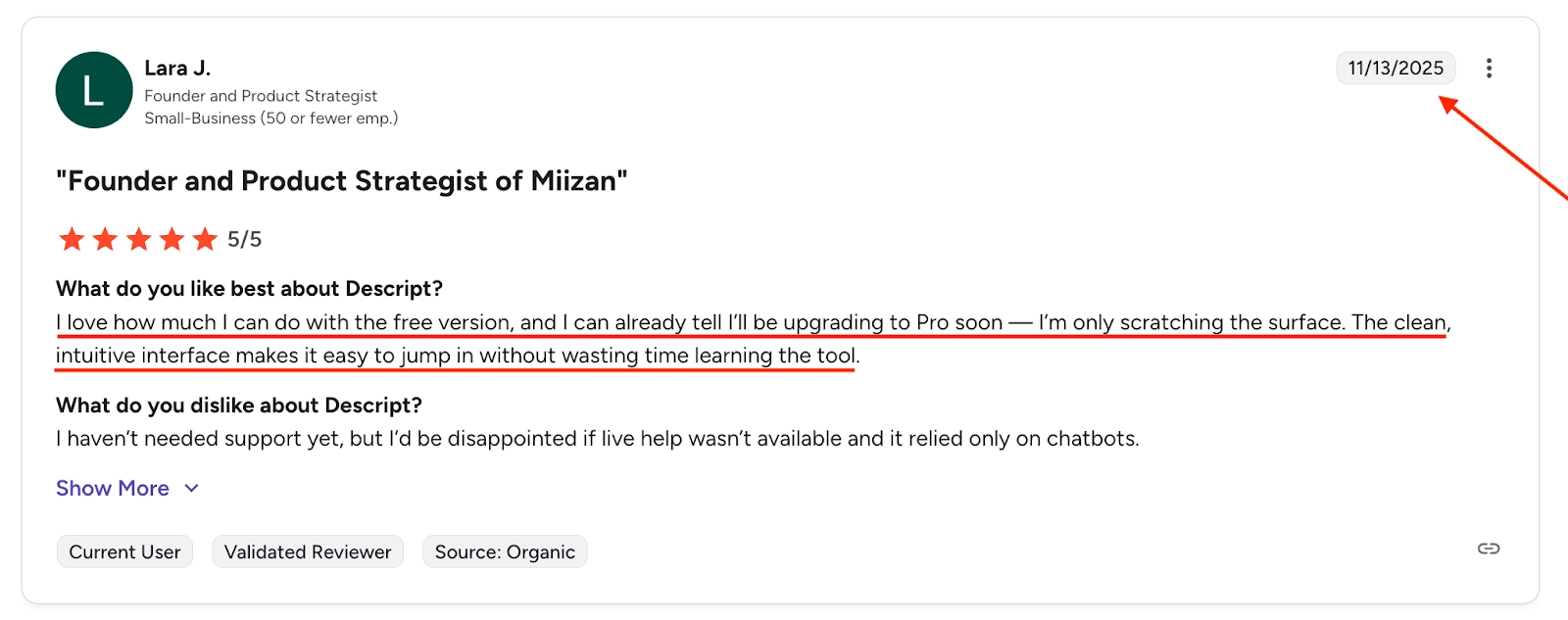
2. InVideo
InVideo focuses on rapid video assembly using AI scripts, templates, and stock assets; so it’s ideal for high-volume social teams that don’t need frame-level editing control.
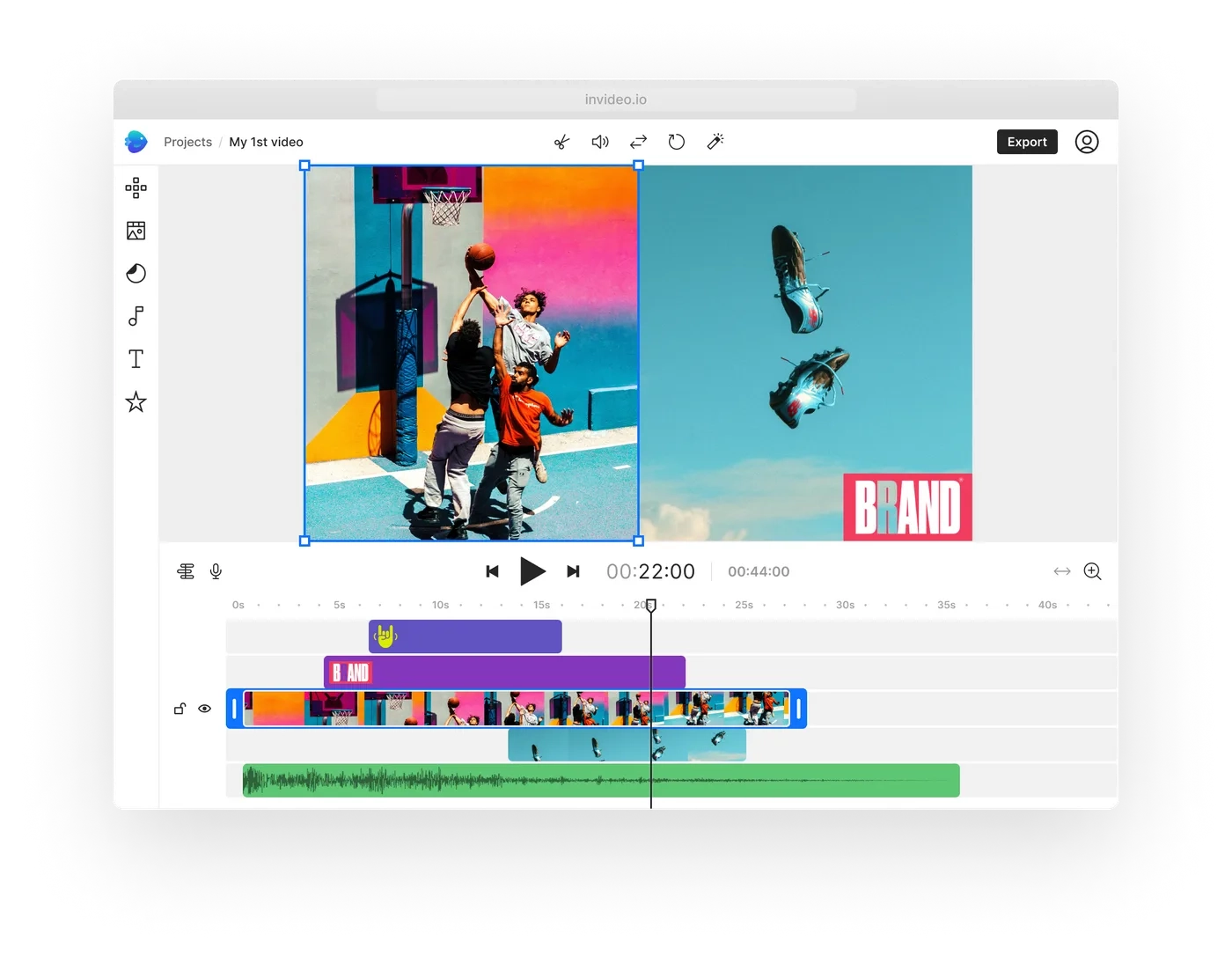
G2 rating: 4.5/5 ⭐
InVideo’s best features:
- 5,000+ templates for every social format; drag-and-drop editing built around ready-made video layouts.
- AI script-to-video generation to turn blog posts, text prompts, or scripts into finished videos automatically.
- Massive stock library; access millions of royalty-free images, clips, and music inside the editor.
- Brand kits and collaboration; upload brand colors, fonts, logos, and work with teammates directly in the platform.
InVideo pros:
- Extremely fast content creation; templates and AI reduce editing to minutes instead of hours.
- Beginner-friendly interface.
InVideo cons:
- Limited manual editing options; finer, frame-level control is restricted compared to traditional timeline editors.
- All videos exported on the free plan include an InVideo watermark.
InVideo pricing
InVideo pricing starts at a free plan, with Business at $15/month, and Unlimited at $30/month when billed annually. Both plans are also available as lifetime deals from $399 as of November 2025.
3. Clipchamp
Clipchamp is Microsoft’s built-in, beginner-friendly video editor designed for quick cuts, basic effects, and easy exports. The platform suits Windows users best who don’t need advanced AI tools.
G2 rating: 4.2/5 ⭐

Clipchamp’s best features:
- Simple drag-and-drop editor with trimming, splitting, cropping, and timeline basics.
- Built-in screen and webcam recording; up to 30 minutes per clip.
- Stock library of music, sound effects, and videos.
- Auto-captions and basic text tools for social videos.
- Direct integration with Windows, OneDrive, and Microsoft 365.
Clipchamp pros:
- Extremely easy to learn; ideal for non-editors, students, and small businesses that need quick, simple videos
- Native Windows integration; fast performance and one-click access through Windows 11
Clipchamp cons:
- Lightweight AI features; offers captions, voiceovers, and noise reduction, but lacks deeper AI editing tools like text-based editing, highlight detection, dubbing, or AI-generated video compared to apps like VEED or Descript.
- Browser-only with limited rendering control; hitting the browser’s back button can take you out of your project entirely.
Clipchamp pricing
Clipchamp’s core editor is free with 1080p exports, and its upcoming Premium tier (launching in 2026) will add 4K exports, premium assets, and advanced brand features for Microsoft 365 subscribers.
4. Pictory
Pictory is an AI-first video platform built to convert text, blog posts, URLs or long-form recordings into short, branded videos without heavy editing.
G2 rating: 4.6/5 ⭐
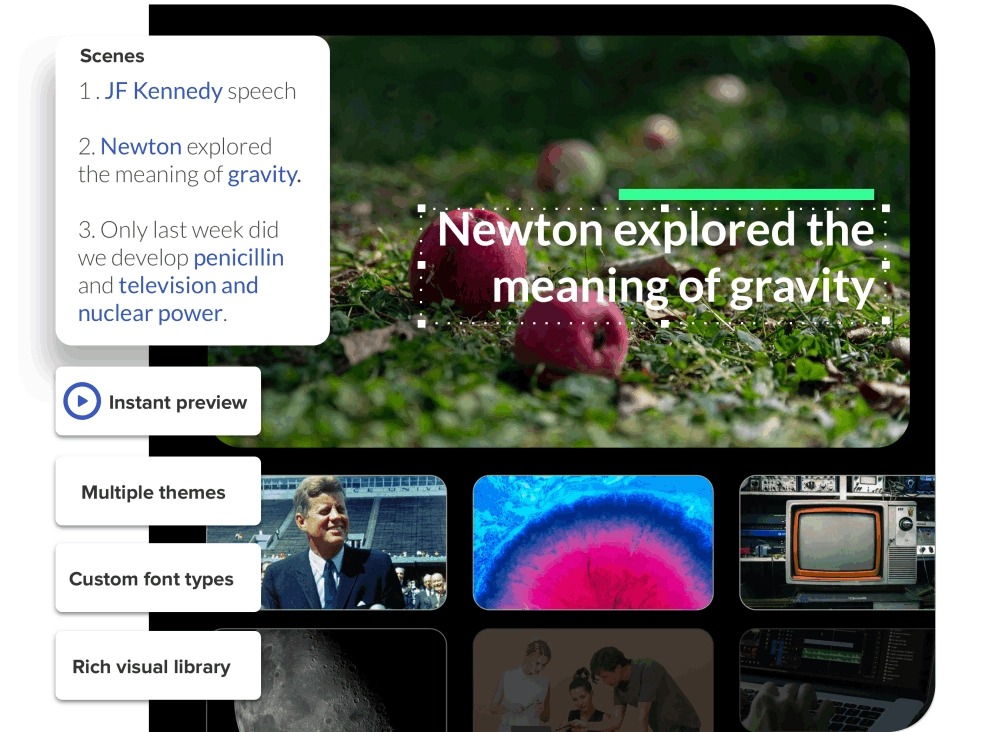
Pictory’s best features:
- Text-to-video and URL-to-video generation to turn scripts or blog URLs into videos automatically.
- Automatic captioning, scene detection, and highlight extraction
- AI voices and stock library to choose from multilingual AI narrations (29+ languages) and millions of stock clips, photos, and music tracks.
- Brand Kit tools let you apply your logo, colors, fonts, and consistent branding across every auto-generated video.
Pictory pros:
- Blog posts, podcasts or webinars become shareable videos in minutes with minimal editing.
- Very user-friendly for non-editors; great for marketers or content teams who don’t want to wrestle with timelines
Pictory cons:
- Advanced editors may find fewer customization options and less frame-by-frame control than traditional NLEs.
- Shorter max video length per plan and AI-chosen visuals sometimes feel generic.
Pictory pricing
Pictory offers a free trial, with paid plans starting at $25/month, while higher-tier plans run $49–$119/month for more video minutes and advanced features.
5. Quso.ai (formerly Vidyo)
Quso.ai specializes in breaking down long-form videos—podcasts, Zoom calls, webinars—into short, platform-ready clips, using AI to detect highlights, add captions, and format everything for social media automatically.
G2 rating: 5/5 ⭐
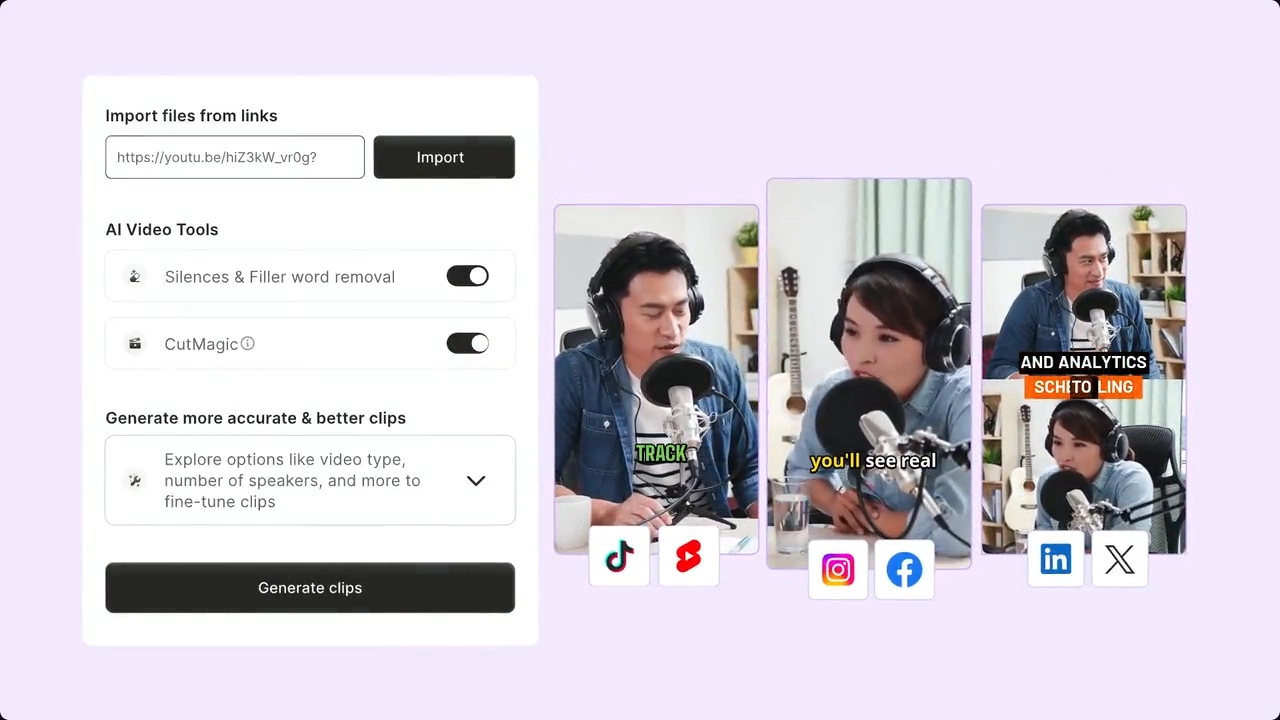
Quso.ai’s best features:
- Upload a long video and Vidyo’s AI identifies highlight moments, auto-splits and formats into multiple shorter clips for social.
- Built-in captioning and automatic output resizing (for Reels, Shorts, TikTok)
- Use premade templates, apply your brand styles, and generate clips in batches rather than one at a time.
Quso.ai pros:
- Ideal for content teams focused on volume over polish
- Automates clip generation and applies your brand assets automatically
Quso.ai cons:
- Quso.ai shows a perfect 5-star G2 rating, but it’s based on just one review.
- Pricing and minute caps may hit fast for heavy volume.
Quso.ai pricing
Quso.ai offers a free plan with 75 monthly credits and 720p exports, while paid plans start at $24/month (Lite) and go up to $33/month (Essential/Growth annually) with 1080p exports.
6. Submagic
Submagic is designed for creators and teams who need fast, polished captions, auto-clip generation, and social-first video editing in minutes.
G2 rating: 4.7/5 ⭐
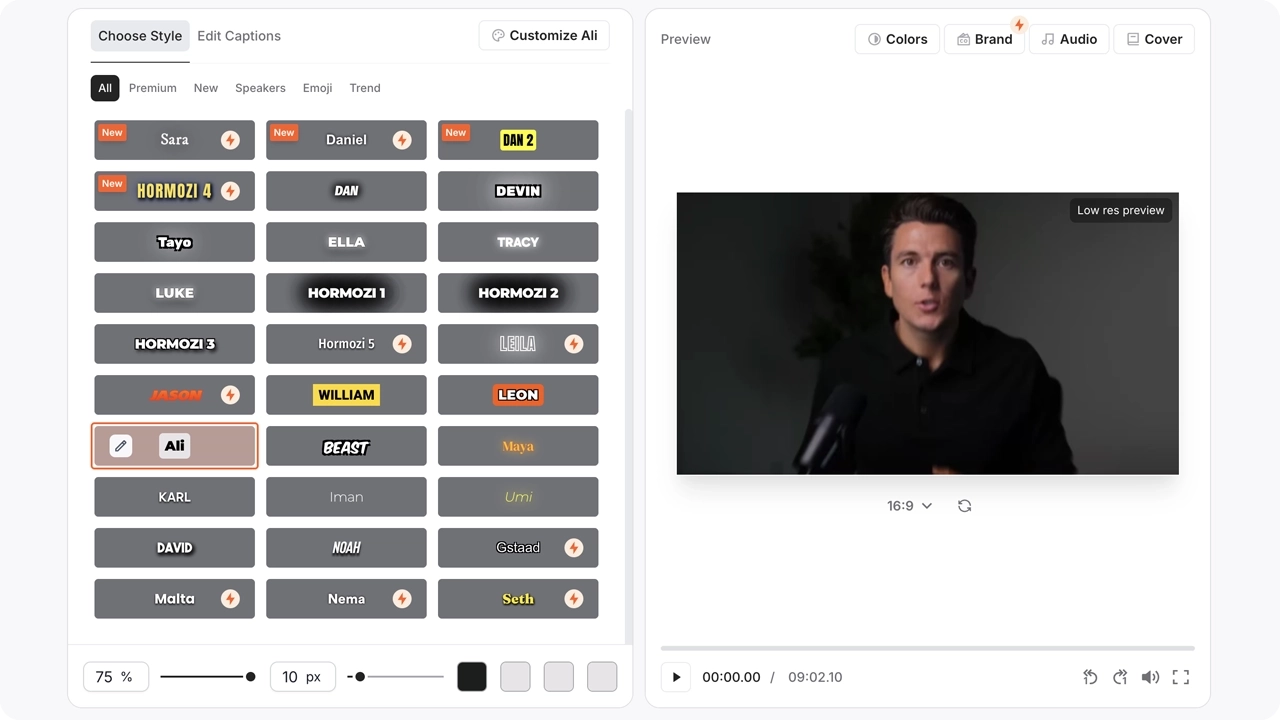
Submagic’s best features:
- Auto subtitle generator with 100+ language support; upload a video or paste a YouTube link and get accurate, styled captions instantly.
- Magic Clips, auto-B-roll, and auto-zoom; AI extracts key moments, resizes to social specs, adds b-roll and transitions in one click.
- Text-based trimming and social export; trim by editing text, apply brand styles, and export for Reels/Shorts/TikTok in 1080p and 30 fps.
Submagic pros:
- Very efficient for short-form content; the tool quickly turns captions and clips into share-ready content without deep editing.
- The focus on captions, hooks, auto-resizing and trending formats means less manual formatting for TikTok/Instagram.
Submagic cons:
- Heavier focus on captions and social-first text effects; not a full production editor for long-form or multi-layer video work.
- Upload and export processes can lag significantly when handling anything beyond short clips.
Submagic pricing
Submagic offers a free trial that lets you create three videos with full AI captions and basic exports, with paid plans starting at ~$19/month and going up to ~$69/month for higher video limits, longer durations, and 4K exports.
7. Fliki
Fliki turns scripts, blog posts, and even simple prompts into AI-generated videos with realistic voiceovers. For this reason, it’s ideal for creators who need fast explainers or social clips without filming anything.
G2 rating: 4.7/5 ⭐
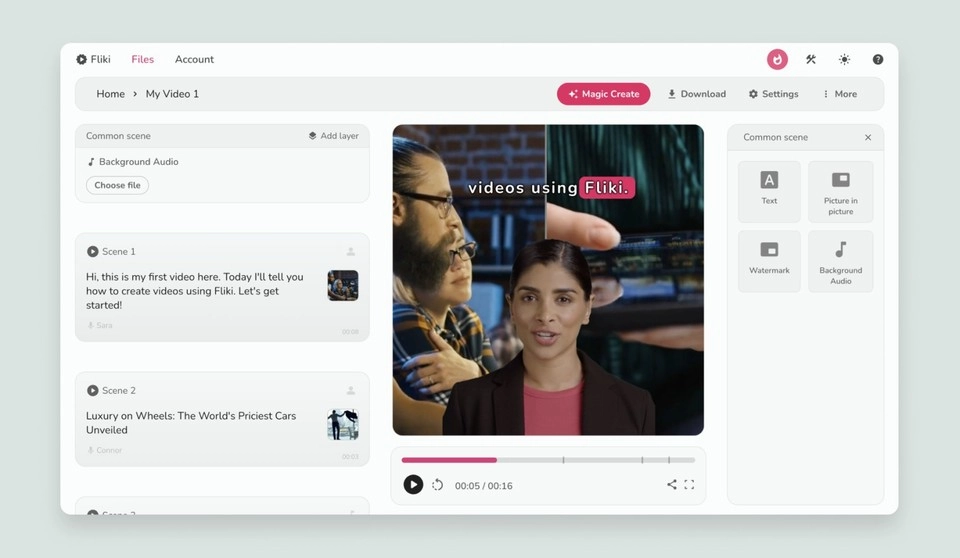
Fliki’s best features:
- Text-to-video generation; paste a script or blog URL and Fliki auto-builds a full video with scenes, captions, and stock visuals.
- 900+ hyper-realistic AI voices; choose from multilingual, emotion-based, and character voices for narration.
- Huge stock library; access premium images, clips, music, and AI-generated visuals.
- Auto-subtitles and brand elements to add captions, logos, and on-brand styling for quick publishing.
Fliki pros:
- Fantastic for faceless content; explainer videos, social snippets, and narration-driven videos come together in minutes.
- High-quality AI voices—among the most natural-sounding in this category.
Fliki cons:
- AI-selected clips sometimes feel generic or slightly off-theme, requiring manual swaps.
- You get basic scene changes, but not the deeper transition library of full editors like Descript or VEED.
Fliki pricing
Fliki offers a free plan with 5 minutes of monthly credits, while paid plans start at $21/month for HD video and premium voices, and scale up to $66/month for longer video limits, multiple voice clones, AI avatars, and advanced commercial-use features.
How to choose the right VEED.io alternative?
Before you pick an alternative, zoom out. Your “best” tool depends on what you make, how you edit, and how fast you need to ship.
Here’s a quick matrix to help you choose:
Why Descript is the best VEED.io alternative for 2026
By this point, the pattern is obvious: VEED is good for getting in and out of videos quickly, but the moment your workflow expands beyond that, you need a tool built for more than captions and templates.
Descript is that tool.
Instead of “Frankensteining” three or four apps, Descript gives you text-based editing, Studio Sound, AI voices, multitrack control, screen recording, hosting, publishing integrations, and platform-ready exports—all inside one workspace.
Plus, it’s also the only platform on the list with stronger third-party ratings than VEED.io. Software Advice’s November 2025 head-to-head comparison scores Descript at 4.7 stars vs. VEED’s 3.8, reflecting exactly what real users say about reliability, control, and day-to-day editing comfort.
If you’re looking for a VEED alternative that can handle serious editing and more complex workflows without making things more complicated, Descript is the upgrade.
👋 Try Descript for free today.
Frequently Asked Questions (FAQs)
Is Descript better than VEED.io?
For most creators, Descript is better than VEED.io. Especially if you work with talk-based videos or podcasts, Descript offers text-based editing, stronger AI cleanup, better collaboration, and more reliable exports. Independent ratings agree: Software Advice’s November 2025 comparison scores Descript at 4.7 stars vs. VEED’s 3.8.
What is the best free VEED.io alternative?
Descript’s free tier is the strongest all-round VEED alternative for creators who edit regularly.
Can I use Descript for social media videos?
Descript is perfect for social media videos. Export in social formats, compress MP4s, resize for Reels/Shorts and add captions, making it fully usable for social video workflows.
Does Descript support MP4 export and compression?
Yes, Descript supports exporting as MP4 with compression presets (Low, Medium, High) and includes a built-in MP4 Compressor tool for resizing and optimizing files.
Which VEED.io alternative works best for teams?
Descript is a strong choice for teams because of its text-based editing, version control, real-time collaboration tools, and ability to host/share links internally.























%201.svg)





